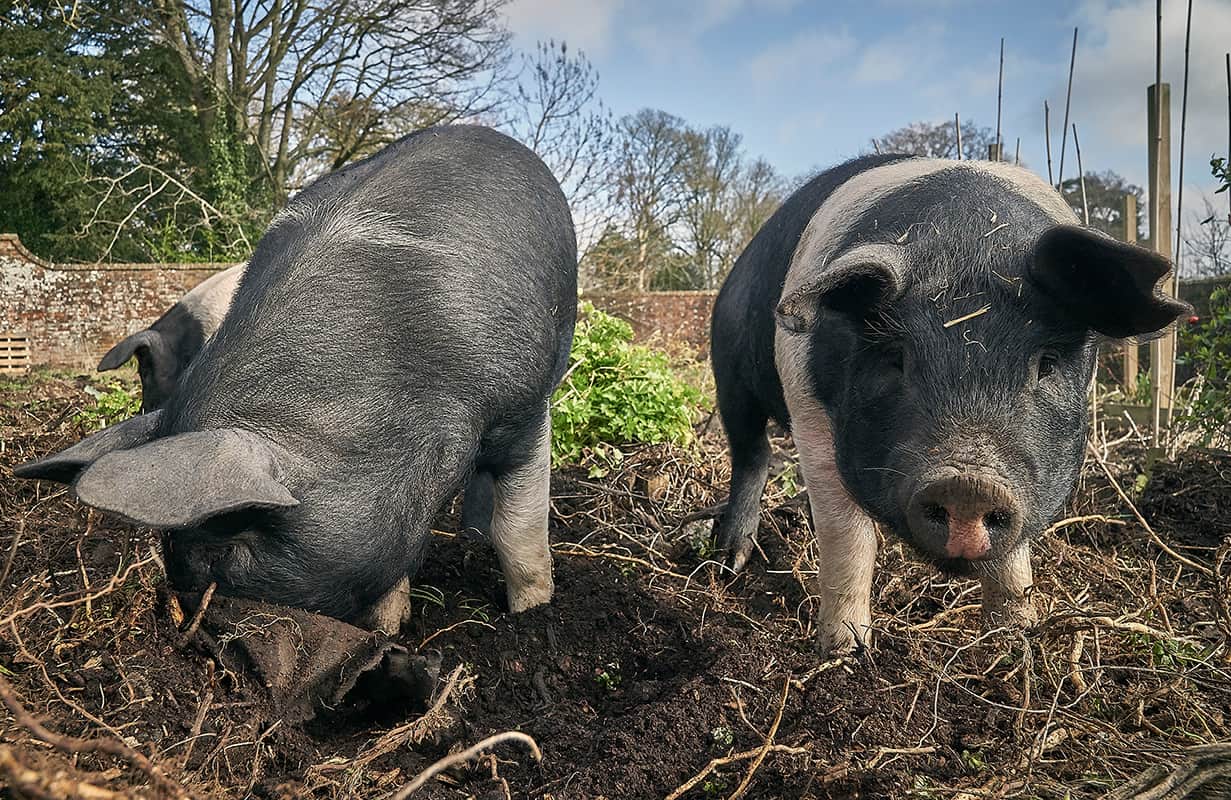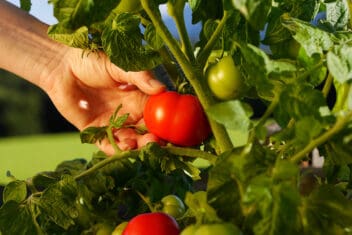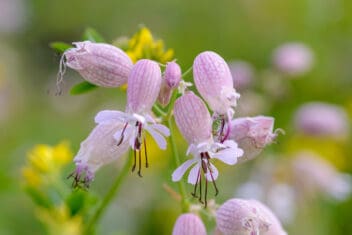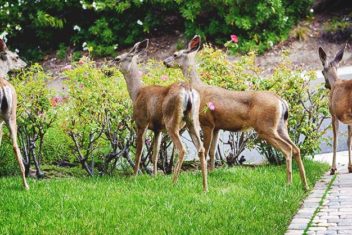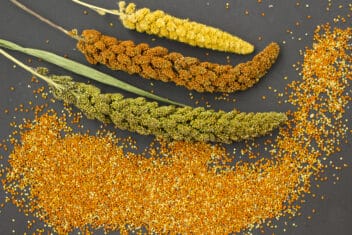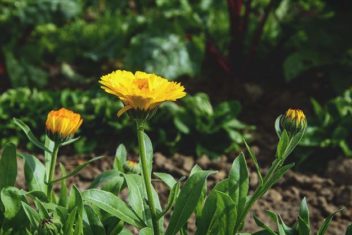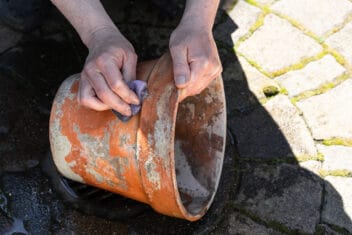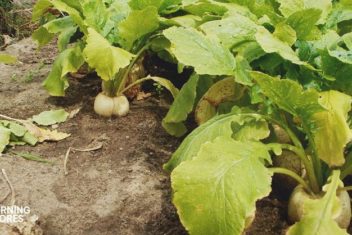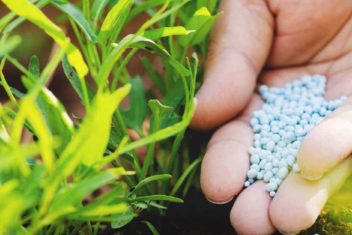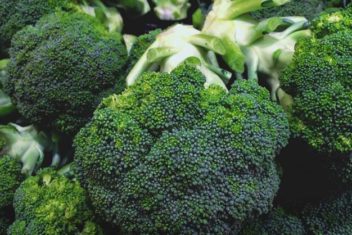Raising pigs for meat? Put them to work! Pigs make great rototillers and will dig up your garden naturally, saving you money and labor. Plus, they fertilize and eat annoying pests as they’re working.
Many farmers waste precious energy trying to make their pigs stop rooting. Instead, why not harness that energy? It’s a win-win situation.
This guide will help you pick the best breed and get your hog helping out with the gardening. Let’s get started.
Pigs as a Ground Tiller? Yes, Really!
Pigs naturally use their snouts to explore their environment and to search for food. This is called rooting. They push their noses right into the ground and flip over sections of sod to look for bugs and get at roots.
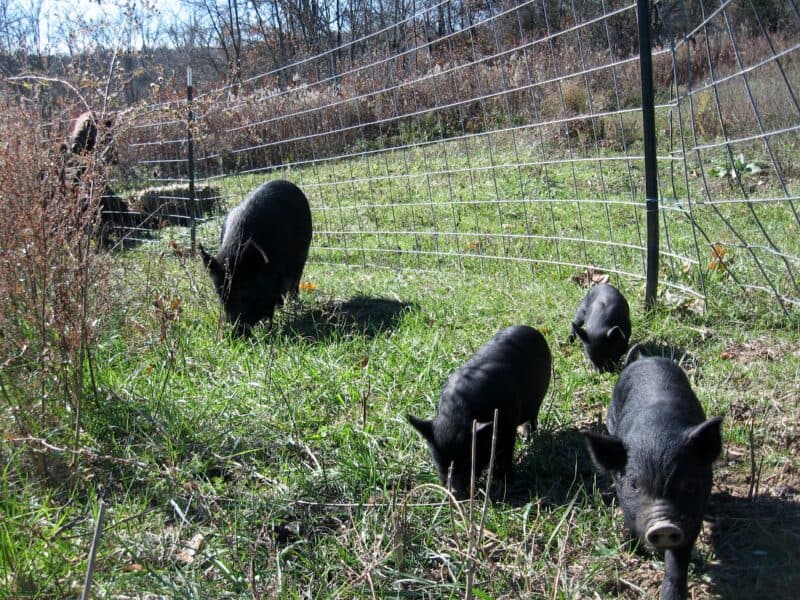
In fact, pigs do such a good job that Hank Will, the former editor of Mother Earth News and Grit, compared the tilling by his Mulefoot hogs to using a chisel plow shank.
While it’s can be devastating if pigs root in an area where you don’t want them to, they’re a back saver in designated areas.
Pigs Save You Time and Money
Tilling and preparing garden spaces takes time, especially if you are breaking new ground or sod. It often takes several passes with a rototiller to break up the sod, and the tiller will only go down into the first 6-8 inches of soil.
A pig can dig much deeper, and they most likely enjoy the task much more than you do.
It’s amazing how strong their heads are, and they can dig up heavy rocks and move them out of the way. They even move those rocks to the edge of the area they’re rooting through, making it easier for the farmer to pick up and remove them.
Hogs eat many garden pests, including snails and grubs. In addition, they eat the grass and weeds right down to the roots helping to eliminate them.
Furthermore, pig labor is cheap. They don’t use gasoline or oil and you don’t have to invest in a machine that requires maintenance.
The bottom line is that pigs save you time that you can use to do other tasks on the farm, along with saving you some cash.
Lower Your Feed Costs
Pigs are omnivores. They eat both animal and plant foods. Having them out on pasture or in the garden provides both types of foods and lowers the number of grain supplements you need to feed your hogs.
When pigs dig in the earth, they’re eating pests that live in the soil, along with weeds, and perennial grasses.
Hogs Help With Fall Cleanup
Are you ready to put your garden to bed for the winter? Let your pigs help.
Pigs turn the soil and clean out all the weeds. A smart plan is to follow the pigs with chickens who will gobble up the exposed insect eggs and larvae that the hogs leave in their wake.
Crabgrass, knotweed, stinging nettle, and poison ivy all spread by underground rhizomes. When the pigs dig in the garden, they root out and often eat these perennial weeds.
Basically, you’re getting a free weed puller at the end of the growing season (and all throughout the year)!
What Breeds Are Best?
Heritage breeds are the best for plowing your garden because they love being outside and have a natural tendency to root. In other words, they’re more closely in-tune with their natural instinct to burrow and dig in the dirt than some of the commercial hogs.
Heritage animals are those traditional breeds that were developed to be hardy and produce food on a homestead environment, so they’re more adapted to the farm environment that commercial breeds.
In addition, they convert to meat efficiently. The Livestock Conservancy has a great comparison chart of heritage pigs to help you decide which breed may be best for you.
Here are some of the more popular breeds to get you started.
American Guinea Hogs
The AGH is a fabulous homestead pig and my personal favorite. They’re a smaller breed, usually weighing less than 250 pounds. If you have other livestock or pets, they’re extremely friendly and get along well with other animals.
Guinea hogs have bristly black hair and do well in the south since they don’t overheat easily. As you can see by my photos, mine do well in moveable sheds all year long. They’re also great mothers and do well raised on pasture.
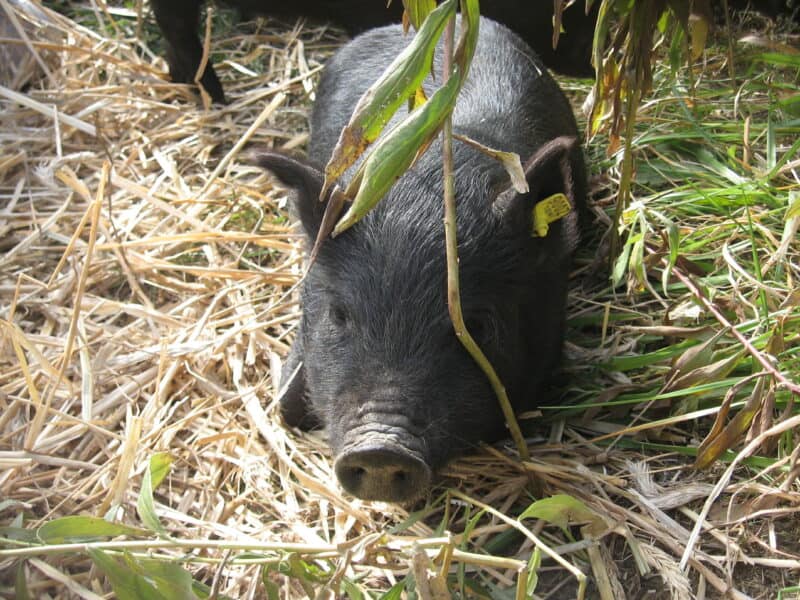
Hereford
Like Herford cattle, these pigs are a pretty brown and white color. Often described as well-muscled, they grow faster than the average heritage hog.
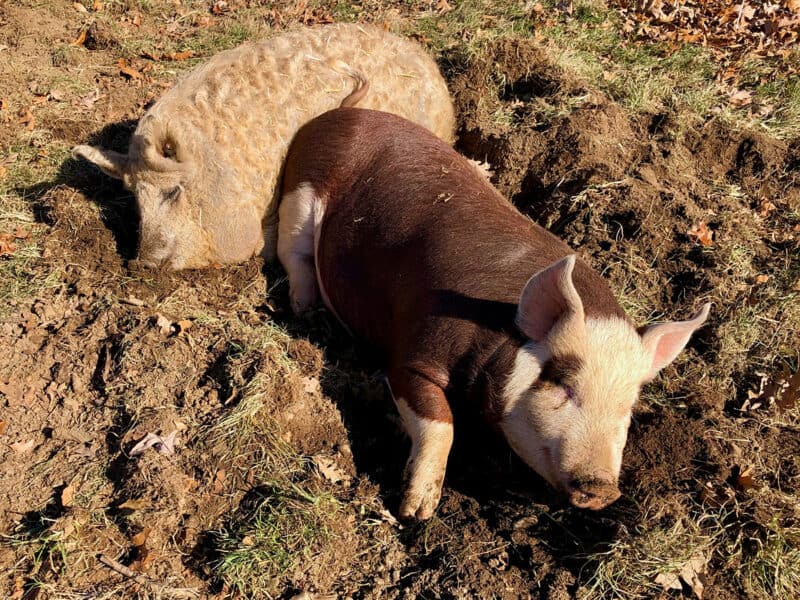
They get about 600 pounds when fully grown and are quite docile. They’re a good option for a novice owner.
Mulefoots
This may be the most popular hog for serious homesteaders who want to raise hogs on pasture and use them for digging gardens and foraging.
A docile, friendly pig, it can be hard to find breeders since the LBC considers them critical, which means their populations are low. A slow grower, they top out at between 400-500 pounds.
What makes them particularly good as tillers is that despite being calm and accepting, they’re quite active. That means they’ll be out there working in the garden more than other breeds.
They also have solid hooves and are excellent foragers, which makes them just about ideal.
Figure Out Fencing
The key to managing your pigs while tilling is to have a sturdy fence. Fencing is essential to keep them in the area you want them to dig in and out of the places you don’t.
Like me, you may have your gardens fenced in so that your livestock can’t get into the garden. Personally, I have a problem with wandering goats, but that is another story!
If your garden is already fenced in, then it is easy to move the pigs into the area.
Electric Fence
If your garden isn’t already fenced or you want to till one section of the yard and not the whole thing, then an electric fence is a good option. Pigs are intelligent and learn quickly to respect the electric zap. As long as they have ample room with plenty of food options, they won’t test the fence.
I prefer electric netting over wires. The small holes and the fact that it goes to the ground are advantages. It helps keep smaller pigs and piglets in and also prevents larger pigs from pushing through the fence.
Netting is also easy to roll up and move around to new garden or pasture areas that you want to be cleaned.
Make sure you have a live wire near the soil level. The lowest electric strand should be within 4-6 inches of the ground. That’s because pigs are famous for digging or crawling under a fence.
You need to have a source of power, whether that’s conventional electric or solar power. You should be checking the fence regularly to see if you have power running through it. For solar systems, you need to make sure the battery is functioning.
Once you have it in place, electric fencing needs maintenance. Make sure the grass isn’t touching the lowest strand and causing the fence to short out.
Additionally, check frequently to make sure you are providing a minimum of 2,000 volts.
Cattle Panels
My personal preference is using cattle panels. As I’m off-grid, it’s easier maintenance for me. I use portable pens with sections of cattle panels set up around the pen.
The pens are small wooden structures that are built on skids. They were built with scrap and recycled wood, which kept the cost low. They’re easy to move with a tractor (or even a car).
Cattle panels are four feet tall and 16 feet long. They’re made of heavy gauge steel that doesn’t bend or bow when an animal rubs on them. This also makes them less flexible during installation.
I attach the cattle panels to steel fence posts that go around the pen in a U shape. I place the posts about eight feet apart, so there are three per panel.
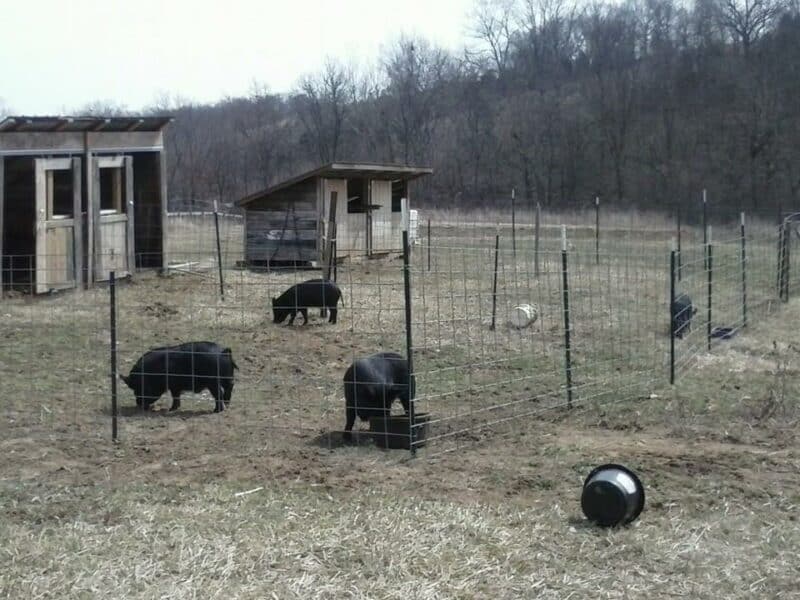
In smaller garden areas I fence the area off move the pigs into the space area without their pens. The pens are heavy and I don’t want to compress the soil.
How to Put Your Pigs to Work Tilling the Garden
Once you have your fencing in place, it’s time to put your pigs to work. Here’s what you should know.
No Nose Rings
Nose rings are used on pigs to prevent them from rooting and to give the farmer control. Nose rings have become popular with commercial farmers who raise pigs in environments such as on cement floors.
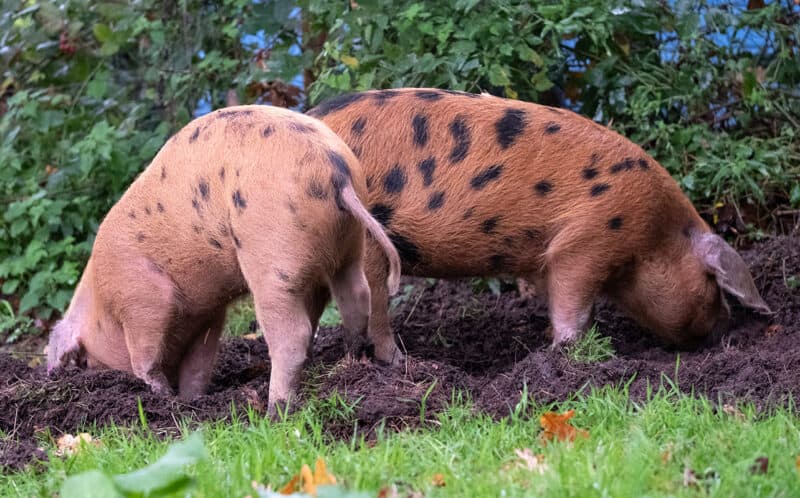
Sustainable farmers consider them cruel because they limit the pigs ability to find food and communicate naturally.
In addition, nose rings inhibit other natural behaviors that keep the pig healthy. Digging and wallowing help to keep pigs from overheating. Nose rings also have been shown to inhibit digging in straw for making a nest in female pigs with young.
Plenty of Fresh Water
Tilling is hard work and your pigs will get thirsty. Pigs don’t sweat and can get overheated if they’re out in the field.
Make sure to provide them with plenty of fresh water when they are on the job.
The Art of Moving Hogs
The secret? Just like with children, bribery works well!
My pigs are friendly and know me. They’ll also follow a grain bucket anywhere.
I have two options when moving hogs to new garden spaces. I can lock them up in their stall, and they can have an amusement park ride as the tractor pulls them to a new location.
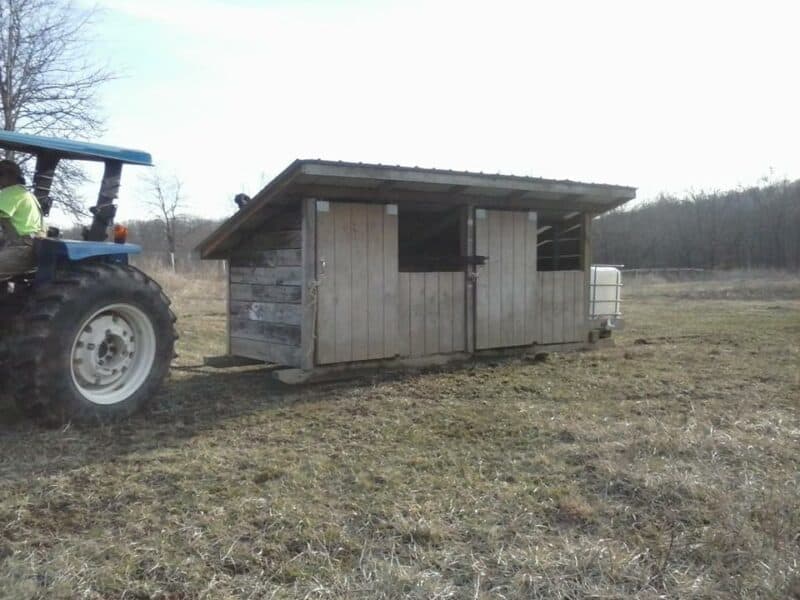
Or I can let them run around while I take down the fence, move the pen, and replace the fence. They’re easy to round up with some corn.
It’s a Win-Win Situation
When I bought my farm, it was just land and had only been used to graze cattle. This left me with a clean slate but lots of well-established sod and weeds.
Thanks to my pigs working in the fields, the land quickly gave way to garden and orchard areas.
If you are raising a pig or two, this method is a great way to allow them to do what comes naturally. Pigs love to dig and grub around in the earth. They will even dig up rocks so you can remove them from the garden area.
All while you’re allowing them to do something they naturally enjoy.
